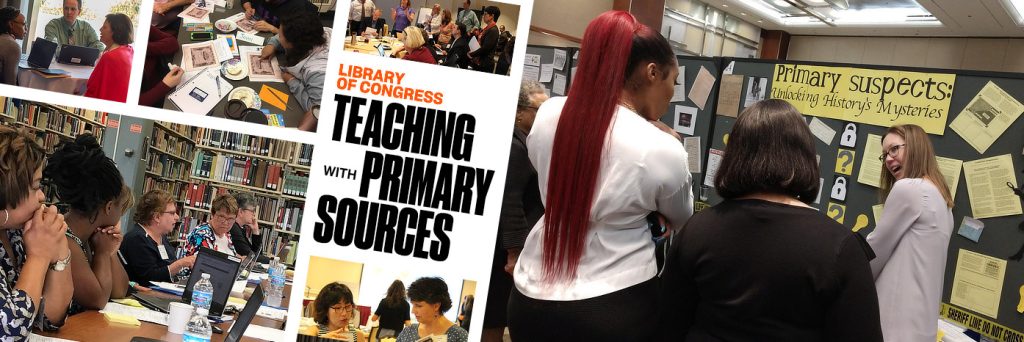We spoke with Lia Atanat, our Maryland History Day Outreach & Professional Development Coordinator, about our new collaboration with tribal consultants and teachers in creating inquiry kits about the Indigenous history and culture of the land now known as Maryland.

Q: Could you quickly describe the inquiry kits for our readers?
A: Sure! The inquiry kits are online sets of historical sources that all pertain to a certain, specific topic. We started creating them in 2016 with funding from a Library of Congress Teaching with Primary Sources grant.
The kits have proven to be useful for students looking for research topics, and for teachers looking to introduce a class unit or practice primary source analysis skills with their students. They cover topics like landmark court cases, important historical phenomena like the Civil Rights Movement, but also lesser-taught histories like Queen Lili’uokalani of Hawai’i.
Q: What first sparked the idea for these new inquiry kits?
The Indigenous Maryland Inquiry Kit project grew out of a collaboration with a number of other organizations who are all looking for ways to get local Indigenous sources and stories out to teachers, students, and the broader community.
It really started with the Maryland State Archives (MSA), who last year published the Mayis Indigenous Records, an online database that will contain transcriptions of all of the records in their collections that mention Indigenous people and place names. They reached out to local organizations like the Maryland State Department of Education (MSDE), the Maryland State Arts Council, the Chesapeake Bay Maritime Museum, among others, to find ways to make their records more accessible to teachers.
We already had this great platform for contextualizing and sharing source sets with teachers, so the idea came together organically from there.
Q: What are the outreach team’s hopes for this collaboration and final product?
A: We hope that these kits will contribute to a revision in the way the history of Native Nations has been taught until recently—as people relegated to the earliest years of the history of European colonization, as people who made less contributions to history than European colonists, and as minor players in Maryland and US histories.
MSDE has recently revised their social studies standards to include Indigenous Maryland history and culture, and we hope to align with their vision of inclusion. One of the important takeaways, as simple as it sounds, is that there are still Indigenous people in Maryland, who are often left out of the conversation about local history, heritage, and culture.

Q: Can you talk about your work with English Language Learners and how this relates?
A: We’ve been striving to make our work with History Day and the inquiry kits accessible to the growing population of English learners in the state. A large percentage of those English learners have Indigenous Latin American background. Even though their background will generally not include local Maryland tribes, we hope that inclusion of indigenous perspectives will also be meaningful to those students, through solidarity with other Indigenous identities and a shift in how the curriculum portrays colonized people.
Q: How are you working with tribal leaders? Have you learned anything so far about working with them?
A: For this project, local tribal leaders and community members will work with us as paid consultants to ensure that the new kits portray Indigenous culture and history with accuracy and respect. The tribal leaders I’ve worked with so far, who include members of the Nause-Waiwash Band and Pocomoke Nation, have expressed how difficult it is to get young people engaged with Indigenous communities, cultures, and stories. They are open to exploring new formats and digital media that kids will find accessible and appealing, and that includes youth in their own communities. I think the new inquiry kits will fit in well with that vision, and in addition to making their stories more broadly accessible, they will help to equip communities with a curriculum development tool to pass down their stories to new generations of tribal members.
Q: How are you collaborating with teachers?
A: MSA and MSDE ran a workshop this summer to provide training to teachers in local Indigenous culture and history. The participants spent four days learning how to find and use Indigenous historical sources, they learned about the Mayis database, they attended sessions led by tribal leaders and members, they visited sites relevant to Indigenous culture and history, and they created lesson plans to bring that new knowledge to their classrooms. We plan to recruit our kit creators from among the teachers who participated in that workshop. This will allow us to be selective and make sure that the new kits align with our goals and our tribal consultants’ requests. We also know that having teachers create the kits will ensure that they are useful to other teachers.
Q: What kind of professional development resources are you planning for teachers?
A: We’re planning to create a teacher guide module that will introduce teachers to the Indigenous MD kit collection, including what types of sources they might encounter in the kits, how to use them, how the kits align with the new social studies curriculum, and where to learn more about Indigenous histories and communities in Maryland. We know that the majority of social studies educators don’t have extensive training in Indigenous history, so we plan to include a bibliography that will help provide background knowledge to teach those lessons.
In addition to that digital resource, every year the MHD outreach staff offer to hold workshops for teachers at their August district in-service days. Next August, in addition to our usual workshops on History Day and the broader body of inquiry kits, we’d like to hold some sessions to introduce the new Indigenous MD kits.
Q: What impact are the inquiry kits in general having? What responses are you hearing from teachers and students?
A: Every year, the outreach team introduces the inquiry kits to students in the classroom, to teachers across Maryland, and we even present them to educators at national conferences. Teachers appreciate the ways many of the kits align with units they teach, making it easy for them to grab a set of sources to use in the classroom. Students, on the other hand, appreciate that the range of topics covers a broad variety of interest areas – a student who is not interested in traditional history topics might find our kits relating to sports, the arts, or science and it can open the way for them to get interested in doing research. I see this extending to the new collection of kits as well – the stories of Indigenous people that we will tell will not just be the conflicts and treaties they had with Europeans; they will touch on environmental science, craft, and lifeways, many of which are still carried on or still affect people in Maryland.
Q: Is there anything else you would like to add?
A: I would just say that I am really pleased by the amount of collaboration that has already gone into this project and that will go into it in the coming year. There are so many state and local organizations who we’re proud to be working with, as well as tribal leaders, teachers, and more. Working together, we are able to accomplish so much more and elevate the voices that deserve to be elevated. And again, we thank the Library of Congress for supporting our decision to shift our focus to be able to do that.
The Library of Congress’ Teaching with Primary Sources Program will fund the Indigenous Maryland Inquiry Kits.

